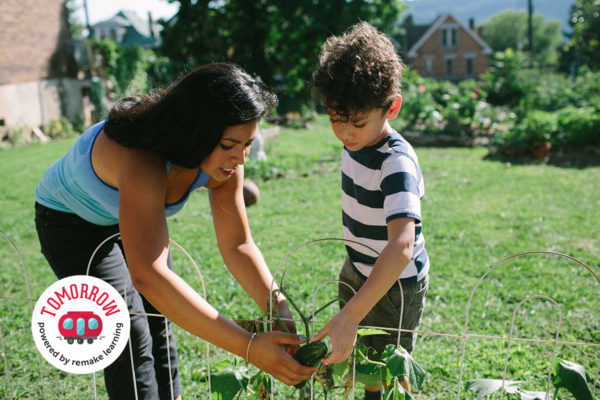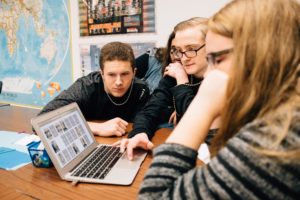
Want students to thrive? Build a learning ecosystem
By Melissa Rayworth
When groups of high schoolers arrive at Carnegie Mellon University’s Entertainment Technology Center (ETC), they’re greeted by a life-sized statue of the Incredible Hulk. These students have come to begin a semester-long project working alongside brilliant people using cutting-edge technology in an environment that’s more like a magical museum than a classroom.
But any intimidation they might feel is soon washed away by a surprisingly approachable message: We don’t have all the answers. We experiment and “play test” ideas. Sometimes we fail spectacularly, and that’s a really good thing.
John Balash, the department’s educational network coordinator, echoes the ETC‘s co-founder Randy Pausch, author of “The Last Lecture,” when he tells the students that “failing forward” is what real-world creating is all about.
So while these teenagers are discovering technologies like virtual reality and 3D printing, they’re also building less tangible skills: problem-solving, effective communication and resilience.
Leveraging community collaboration
These semester-long projects at CMU are just one example of the collaboration that can happen in the Pittsburgh region through the ever-growing Remake Learning network. The seeds for this learning ecosystem were planted 15 years ago. Since then, the network has grown to include 600 school districts, universities, museums, nonprofits and other organizations.
These connections open up huge possibilities, says Kris Hupp, the 21st-century teaching and learning coach at Cornell school district in Coraopolis, Pa. Hupp is currently studying learning ecosystems while pursuing his doctorate in education. The ecosystem concept, he says, doesn’t come with specific prescriptions about which types of organizations should be involved or how collaborative learning should unfold. It’s a flexible approach that can develop in unique and authentic ways in any community.
But wherever and however a learning ecosystem evolves, there are huge benefits to breaking down the silos that have long separated formal education from the rest of daily life. As resources are shared and people from a range of organizations collaborate, opportunities for students multiply.
Learning ecosystems deeply connect students to their physical environment and to the issues in their communities, says Valerie Hannon, an education consultant and co-founder of Innovation Unit. She co-authored the report “Local Learning Ecosystems: Emerging Models,” which states:
“When they engage with a range of resources within a broader community, charged with the power of social interaction in the connected world, learners of all ages, temperaments, and aptitudes can seize greater opportunities that better meet their needs.”
Increasing equity through ecosystems
Among the benefits of a broad and collaborative learning ecosystem: promoting equity.
This fall, the Heinz Endowments will unveil the Pittsburgh Readiness Institute (PRI), a unique, out-of-school-time training program involving schools, local employers and civic leaders in helping students prepare for productive lives at school, on the job and in society.
When you create real alignment between all of these groups, “the learner walks away with a repertoire of not only knowledge but soft skills and social-emotional learning,” says Dr. Stanley Thompson, PRI’s executive director. That, he says, will “propel them into a larger community and help them understand what it means to be a civic and social contributor to the neighborhood and the larger community.”
The PRI’s pilot program will include students from a diverse range of districts in Pittsburgh’s Monongahela Valley, who will tackle community problems while also building connections to potential mentors, internships and future opportunities.
Those connections are especially important for young people in communities “that have been historically kept furthest from opportunity, who don’t have the luxury of developing those types of professional networks and social capital while still in school,” says Carlos Moreno, co-director of Big Picture Learning.
Another benefit: Future teachers can go out into the community to develop a deep understanding of who learners are and what their communities are really like, says Dr. Tyra Good, who has taught education at Chatham University and founded the learning consultancy Good Knowledge Connections.
“A lot of my classes are outside of the four walls of the classroom,” Good says. By bringing future teachers to community meetings and introducing them to families, Good helps dispel inaccurate impressions and negative stereotypes.
The issue of equity became even more visible as the COVID-19 school disruption began, and that led Hupp’s district to leverage community involvement.
Many Cornell district families lacked the home internet access needed for distance learning. “Even with programs like Comcast Essentials,” Hupp says, “not every family was able to take advantage of that.” So he collaborated with others in the community to have them share WiFi signals with nearby students.
In one case, a building owner agreed to drill a hole, hang an antenna outside and share his signal with the gazebo across the street, where students could then access school assignments on digital devices.
“It’s just such a warm feeling to know there’s so many people in the community that want to help,” Hupp says.
As districts assess their futures, “school systems can’t hope to make significant shifts in teaching and learning in isolation from their communities,” education consultant Suzie Boss writes in her book “All Together Now.”
“More than ever,” Boss says, “schools need partners—inside and outside the building—who share and shape their vision. Buy-in from the entire community is essential if students are going to have opportunities to take part in meaningful, real-world learning that extends beyond the classroom.”
Good puts it even more plainly: There is tremendous wisdom, she says, in the African proverb “it takes a village to raise a child.”
This article is part of a series for ‘Tomorrow’ powered by Remake Learning. From May to October, “Tomorrow” will explore – through virtual events, grantmaking, and storytelling – what we can do today to make tomorrow a more promising place for all learners. Follow along or share your hopes for today’s young people using the hashtag #RemakeTomorrow and tagging @RemakeLearning. Learn more about Remake Learning here. And read more “Tomorrow” articles published on Kidsburgh here.
